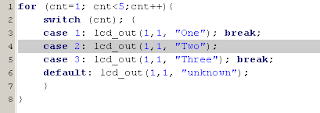Lesson 6.2
The format is
switch(expression); {
case const value: syntax to execute; break;
default: syntax to execute; break;
}
Here is an example:-

When cnt is 1 the text One is displayed on the lcd.
When cnt is 2 the text Two and Three is displayed on the lcd. This is because, case 2, does not have a break, so it continues processing the next line.
When cnt is 3, Three is displayed on lcd.
When cnt is 4 or more unknown is displayed on lcd.
Note: The switch value can only be integer or char.
With case the break is important as illustrated in case 2 in the above example. So be sure to code correctly or you might get undesired results.
Note: default is optional.
Note: default is optional.



1 comment:
it's wrong!!! It doesn't have a ; after the select statement
Post a Comment